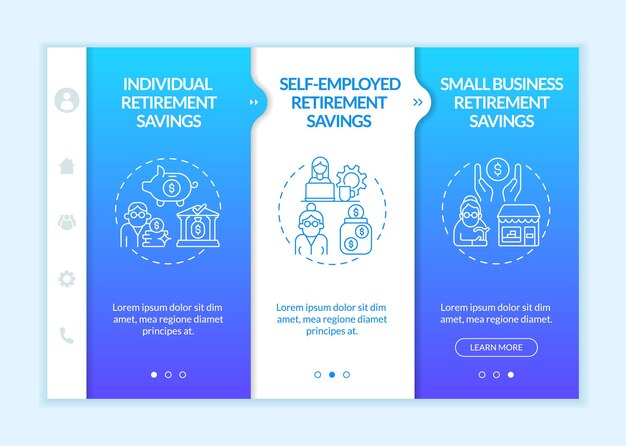Retirement Planning: Integrating Employee Benefits for Long-Term Security

Retirement planning involves strategically incorporating your employee benefits, such as 401(k)s, pensions, and health savings accounts, into a comprehensive long-term financial strategy to ensure a comfortable and secure future.
Are you overlooking a crucial component in your retirement strategy? Retirement planning: How to integrate your employee benefits into your long-term strategy can make a significant difference in your financial security when you decide to retire. Let’s explore how to make the most of these valuable resources.
Understanding the Importance of Retirement Planning
Retirement planning is more than just saving money; it’s about creating a roadmap for your financial future during your golden years. It involves assessing your current financial situation, estimating future expenses, and identifying income sources that will sustain your desired lifestyle. Employee benefits often play a pivotal role in this plan.
Why Start Early?
Starting early allows you to take advantage of compounding interest and grow your savings significantly over time. Even small contributions made consistently can lead to substantial retirement funds.
- Time is your greatest asset when it comes to investing.
- Early planning allows for more aggressive investment strategies.
- You can make adjustments to your plan as your circumstances change.

Failing to plan for retirement can lead to financial insecurity and a reduced quality of life. It’s crucial to take proactive steps to ensure you are prepared for the future. Retirement planning also provides peace of mind, knowing that you have a solid strategy in place.
Maximizing Your 401(k) Contributions
A 401(k) is a retirement savings plan sponsored by your employer. It allows you to contribute a portion of your salary on a pre-tax basis, reducing your current taxable income. Many employers also offer matching contributions, which can significantly boost your savings.
Take Advantage of Employer Matching
Employer matching is essentially free money that can accelerate your retirement savings. Ensure you contribute enough to receive the full match offered by your employer.
Failing to maximize employer matching is like leaving money on the table. It’s a valuable benefit that can significantly enhance your retirement savings. Understanding your employer’s matching policy is essential for making informed decisions.
How to Choose the Right Investments Within Your 401(k)
Selecting the right investments within your 401(k) is crucial for long-term growth. Consider your risk tolerance, time horizon, and investment goals when making these decisions.
- Opt for a diversified portfolio that includes a mix of stocks, bonds, and mutual funds.
- Consider target-date funds, which automatically adjust the asset allocation as you approach retirement.
- Review and rebalance your portfolio periodically to ensure it aligns with your goals.
Maximizing your 401(k) contributions and making informed investment choices can set you on the path to a comfortable retirement. It’s a powerful tool for building your nest egg.
Understanding and Utilizing Pension Plans
Pension plans are retirement plans that provide a guaranteed income stream upon retirement. Unlike 401(k)s, pension plans are typically funded by the employer. Understanding the terms and conditions of your pension plan is essential for effective retirement planning.
Knowing the details of your pension plan is crucial for projecting your retirement income accurately. This includes understanding vesting schedules, benefit formulas, and survivor benefits.
Defined Benefit vs. Defined Contribution Plans
Defined benefit plans guarantee a specific monthly payment upon retirement, while defined contribution plans, like 401(k)s, depend on investment performance.

Pension plans provide a predictable and stable source of retirement income. Understanding how your pension plan works can help you make informed decisions about your overall retirement strategy. Maximizing your pension benefits can provide a solid foundation for your financial security in retirement.
Leveraging Health Savings Accounts (HSAs)
Health Savings Accounts (HSAs) are tax-advantaged savings accounts that can be used to pay for qualified medical expenses. They are available to individuals enrolled in high-deductible health plans. HSAs offer a triple tax advantage: contributions are tax-deductible, earnings grow tax-free, and withdrawals for qualified medical expenses are tax-free.
HSAs as a Retirement Savings Tool
HSAs can be used to save for future healthcare expenses in retirement. Unused funds can be carried over from year to year, and after age 65, you can withdraw funds for any reason, although withdrawals for non-medical expenses will be subject to income tax.
HSAs offer a unique way to save for retirement while addressing future healthcare costs. The tax advantages of HSAs make them an attractive option for those eligible to participate. Integrating HSAs into your retirement plan can provide a financial cushion for medical expenses.
Strategies for Maximizing HSA Benefits
To maximize the benefits of an HSA, consider contributing the maximum amount each year and investing the funds wisely.
- Use the HSA for current medical expenses if needed, but try to save as much as possible for retirement.
- Invest HSA funds in a diversified portfolio to maximize growth potential.
- Keep track of your medical expenses for potential reimbursement in the future.
Leveraging HSAs can provide significant tax advantages and help you prepare for future healthcare costs in retirement. Consider integrating HSAs into your overall retirement savings strategy.
Integrating Social Security Benefits
Social Security is a government program that provides retirement, disability, and survivor benefits. Understanding how Social Security works and how your benefits are calculated is essential for effective retirement planning.
Understanding Your Social Security Benefits
The amount of your Social Security benefit depends on your earnings history, the age at which you begin receiving benefits, and other factors.
Knowing your estimated Social Security benefits can help you plan your retirement income more accurately. This information is available through the Social Security Administration website. Understanding the factors that affect your benefits can help you make informed decisions about when to retire.
Strategies for Maximizing Social Security Benefits
There are several strategies you can use to maximize your Social Security benefits, such as delaying retirement until age 70.
- Delaying retirement can result in a higher monthly benefit.
- Consider working longer to increase your earnings history.
- Coordinate your claiming strategy with your spouse to maximize household benefits.
Integrating Social Security into your retirement plan can provide a steady stream of income. Understanding your benefits and employing effective claiming strategies can enhance your financial security in retirement.
Planning for Potential Healthcare Costs
Healthcare costs are a significant concern for retirees. As you age, medical expenses tend to increase. Planning for these costs is essential for ensuring financial stability in retirement.
Estimating Future Healthcare Expenses
Consider factors such as inflation, potential health issues, and long-term care needs when estimating future healthcare expenses.
Healthcare costs can significantly impact your retirement savings. It’s important to factor these costs into your retirement plan. Estimating future expenses can help you determine how much you need to save.
Strategies for Managing Healthcare Costs
There are several strategies you can use to manage healthcare costs in retirement, such as purchasing supplemental insurance and exploring Medicare options.
- Consider purchasing a Medicare Supplement insurance policy to cover gaps in Medicare coverage.
- Explore long-term care insurance to protect against the costs of nursing home care or in-home care.
- Take advantage of preventive care services to maintain your health and reduce potential medical expenses.
Planning for potential healthcare costs is an essential component of retirement planning. Taking proactive steps to manage these costs can help you maintain your financial security in retirement.
| Key Point | Brief Description |
|---|---|
| 💰 Maximize 401(k) | Contribute enough to get the full employer match and choose diversified investments. |
| 🏥 Leverage HSAs | Use HSAs for healthcare costs, enjoying tax benefits and potential investment growth. |
| 👵 Social Security | Understand your benefits and consider delaying to maximize your monthly income. |
| 🏥 Healthcare Costs | Plan for future health expenses with supplemental insurance and preventive care. |
Frequently Asked Questions (FAQ)
▼
The first step is to assess your current financial situation, including your income, expenses, assets, and liabilities, to understand your starting point.
▼
Contribute enough to receive the full employer match, choose diversified investments based on your risk tolerance, and rebalance your portfolio periodically.
▼
An HSA is a tax-advantaged account for healthcare costs. It helps by providing tax-free growth and withdrawals for qualified medical expenses in retirement.
▼
Understand your estimated benefits by checking the Social Security Administration website, and consider delaying retirement to increase your monthly payments.
▼
Estimate future expenses by considering inflation and potential health issues, and explore supplemental insurance options like Medicare Supplement policies.
Conclusion
Integrating your employee benefits into your long-term retirement strategy is essential for securing your financial future. By understanding and maximizing these benefits, planning for healthcare costs, and considering Social Security, you can create a comprehensive plan that supports a comfortable and fulfilling retirement.





